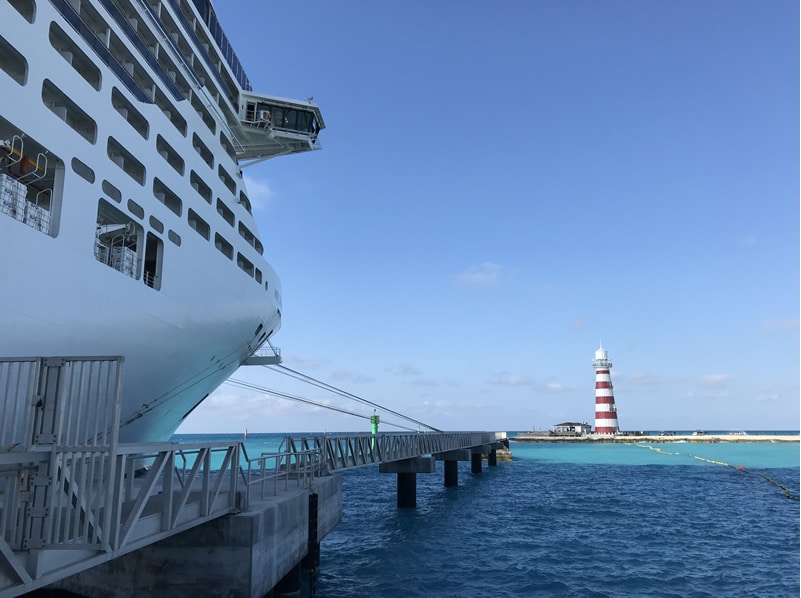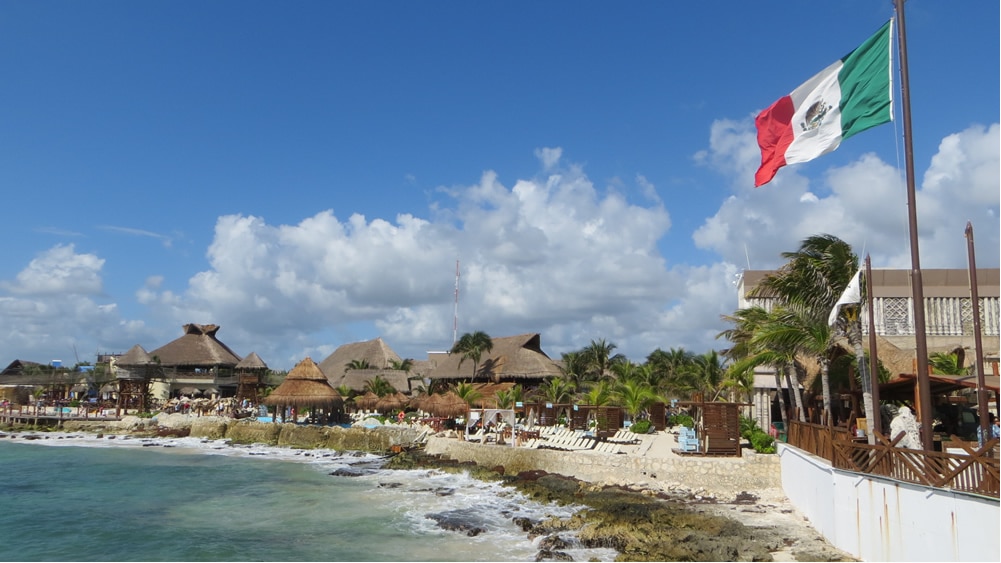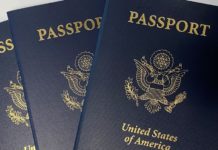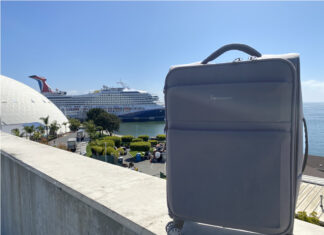Note: The following article is intended for U.S. citizens sailing round trip itineraries from U.S. ports. The rules discussed may not apply for other countries. You also shouldn’t take this as legal advice. Contact your cruise line for their guidance if you would like to do a partial cruise.

For most people, taking a cruise is simple. You hop on from a cruise port in the U.S., sail on the trip, and then return to the cruise port where you embarked.
It’s easy and convenient. These cruises that begin and end in the same port are called “closed-looped” cruises. They are the standard in cruising for Americans and make the process of immigration and customs simple. In fact, you don’t even need a passport to sail (though it is highly suggested).
But there are times where you might not want to — or simply can’t — sail a closed-loop cruise. Some examples include:
- You get sick or injured on your cruise and can’t continue on your journey
- You miss the ship and the cruise departs without you
- You simply want to spend more time in a port city (such as taking a cruise to Cozumel and then staying there for a week)
- It’s cheaper to take a cruise to a port city than it is to fly, so you want to sail there instead
- You have to get back home due to a family emergency
- Your experience on the cruise ship is so bad that you refuse to get back on board
No matter the reason you want to get off the ship early, it’s definitely a common question — but a rare occurrence. The vast majority of passengers simply sail their normal cruise itinerary.
But can you just get off the ship and return home on your own terms?
The answer is yes, but there are some major complications (and laws) that should be considered.
An Old Law Causes Confusion for Disembarkation
You’d be forgiven if you have never heard of the Passenger Vessel Services Act of 1886 (also known as the PVSA). The law was enacted in the 19th century to protect U.S. maritime interests. It is still on the books today, and it essentially says that foreign ships can’t transport passengers between U.S. ports, or they will face a fine.
Today, nearly every cruise ship operates under a foreign flag. That means they can’t pick you up in say, New York, sail to Miami, and let you leave the ship permanently.
The spirit of the law was to keep foreign ships from picking up passengers in one U.S. port and transporting them to another U.S. port, thereby competing with American vessels. Instead, only U.S.-flagged ships can make these trips.
Now, there are certain caveats and exceptions. But the major points are relatively clear regarding disembarking passengers in the United States sailing on a foreign vessel:
- A passenger can’t sail from one U.S. port and get off at another U.S. port (even for the day) without the trip including a foreign port of call in the itinerary.
- If a ship sails a journey to a “nearby” foreign port, a passenger still can’t leave the ship permanently at a different U.S. port than the embarkation point (nearby foreign ports are those in North America like in the Bahamas or Mexico).
- If the ship sails a journey to a “distant” foreign port, the passenger can leave the ship permanently in another U.S. port (distant foreign ports are those outside North America).
In most cases, if you sail from a U.S. port and want to get off at another U.S. port on the same trip, it’s going to cost the cruise line a PVSA fine, which is likely to be passed on to you. (The fine is currently almost $800 per passenger.)
That’s what happened recently on a cruise from New York:
Where there is some question is if the law applies to passengers who depart a U.S. port, but disembark permanently at a foreign port.
In that case, the rules appear to say that it is fine to do so. According to the Code of Federal Regulations:
“Any vessel of the United States, whether or not entitled under paragraph (a) of this section to engage in the coastwise trade, and any foreign vessel may proceed between points in the United States embraced within the coastwise laws to discharge cargo or passengers laden at a foreign port, to lade cargo or passengers for a foreign port, in ballast, or to transport certain articles in accordance with § 4.93.”
In this case, leaving the ship appears to be fine according to the U.S. law. And in fact, there are many cruises that start from the U.S. and then let passengers off in a foreign country, such as Transatlantic trips from the United States to Europe.
Here’s what Customs and Border Protection (CBP) recently said on their website (note that we found this specific passage several years ago, but have been unable to relocate the original source):
“Does U.S. Customs and Border Protection (CBP) fine cruise ships that allow passengers to disembark before the end of the cruise’s itinerary?
“The Passenger Vessel Services Act (PVSA), 46 U.S.C. 55103 (19 CFR 4.80a), is one of the several coastwise laws enforced by CBP which prohibits the transportation of passengers between points in the U.S. in any vessel other than a vessel that has a coastwise endorsement, i.e a vessel that is built in and owned by persons who are citizens of the United States.
“The penalty for violating the PVSA is $300 per passenger carried and is assessed against the carrier/cruise line. For example, an Argentinean-flagged cruise ship picks up passengers in Miami then sails to various ports of call, including Bermuda, Charleston, South Carolina, and Annapolis, Maryland before returning to Miami. While passengers may leave the vessel to see the U.S. ports, they must return to the vessel before the cruise itinerary ends, i.e. before the vessel returns to Miami, in order for the carrier to avoid a PVSA violation. If passengers were to disembark, i.e. finally and permanently leave the vessel in Bermuda, the vessel would not incur a PVSA penalty because Bermuda is not a U.S. point.”
In other words, if you sail on a cruise and leave the ship permanently in a foreign port, then it should be allowed according the U.S. law.
One thing to note: Just because U.S. law does not have a problem with passengers leaving the ship in a foreign country, it is possible that the foreign country could have laws against cruise passengers staying. You’ll want to check with your cruise line for details.
Leaving the Ship Early in a Foreign Port Usually Not Allowed by Cruise Lines

In practice, except in some circumstances (such as a medical emergency) allowing passengers to freely leave the ship permanently in a foreign port appears rare.
For example, Royal Caribbean’s website used to confirm that getting off the ship permanently in a foreign port instead of returning home was ok, as long as you went through the proper channels. In fact, it explained the entire process. Now, it simply says that:
“Royal Caribbean no longer allows cruise passengers to pre-plan early debark or late embarkation for any of our ships.”
Other cruise lines say even less. In fact, searching the website of all the major lines, Royal Caribbean was the only one we found that mentioned anything about debarking early at another port — even if it was to say it’s not allowed.
Want to Leave Early? Always Talk to the Cruise Line First
While others cruise lines made no mention we found of leaving the ship early, it’s worth giving the cruise line a call if you want to leave early and see exactly what their policy is regarding the situation.
If they say that it is not allowed due to the PVSA, you might have to talk to a supervisor (the law does get confusing) as that law only applies to leaving the ship in a U.S. port.
You might also have to fill out some paperwork before disembarking. Keep in mind as well that legal or not, the cruise line may have a policy of not letting passengers debark early.
No matter, if you plan to leave early anyway, be sure the cruise line knows your plans. Otherwise, they may believe they have a missing passenger.
You will also need to inquire about immigration status in the foreign port. After all, while there should be a record of your travel to the foreign country, you won’t have a passport stamp to prove your entry. This could make for a tougher time when exiting the country.
Keep in mind that you will also have to incur the full cost of traveling back home, however you decide to do so. For most people, this means having to buy a plane ticket back home after their stay. It goes without saying that you can’t just hop on the next ship that comes to port to cruise back. Cruises just don’t work that way.
Finally, you won’t get any sort of refund from the cruise line for the days you don’t sail. You’ll have to eat the cost of the entire cruise, even though you aren’t aboard the ship for some of the journey.
The Bottom Line on Taking a Partial Cruise
You should keep in mind that we aren’t lawyers, nor experts in maritime law. Our understanding, however, is that Americans sailing from the United States to foreign ports can end their cruise early (a so-called partial cruise) in another country without any sort of legal penalty.
However, cruise lines themselves may not allow their passengers to debark the ship in a foreign port early. Keep in mind there are also finer points of the law that might apply to your specific situation.
Frankly, we are of the opinion that if you know for certain you want to disembark in a port and not finish your cruise, it’s much easier just to use an alternate way to get there. This way you don’t have to worry about any legal issues, potential fines, or the cruise line’s policies.













Weather caused flight cancellations and I was out on possible space stand by for 4 more flights and did not get there. We missed New York embarkation but thought I would just board the ship, the next stop Cape Canaveral. They charged me $947 per person to do this. US immigration. But if I flew to Cozumel, days later I could get on the missed ship for $50.
I agree these old laws need to be changed for cruise ships, because it is becoming common occurrence for airline malfunction and for medical reasons!
What if it’s a 1 way cruise to Vancouver. The itenerary says we arrive thursday in vancover but the disembarkation is friday morning? Once we leave the ship thursday can we just not come back since that is our final port? Thank you.
I have a booking for a 30 days Carnival cruise in September, from Seattle to Brisbane, Australia. I would love to debark in Indonesia before arriving to Australia. I spent a month in Australia, five months ago and would like to stay in Indonesia longer. Any advice on what should I do to make it happen? Thank you!
The best thing is to call the cruise line. Given that the cruise isn’t a closed-loop journey, you might be able to get off the ship in Indonesia. My understanding is that it doesn’t violate the law, but it can be complex.
On a round-trip cruise to Hawaii from San Diego, I became seriously ill in Hawaii and flew back to Oregon from Hilo. Per the antiquated maritime law, I was fined $941, which is the set fine, not $800. I wish you had included information about whom I might contact to discuss submitting medical documentation to try to get my money back. The cruise line ioffers no help in this.
One suggestion might be calling your representative’s office. They have constituent services that can help with this sort of thing.
Can a cruise line ban you, or put you on a ban list for all cruise lines, if you leave in a foreign country (say for a month), then try to catch a cruise back to the U.S.?
Not sure how you would catch a cruise back to the U.S. from a foreign country. Cruises are sold from the departure port. So if I sail from Miami to Cozumel and back, I can’t buy a ticket from Cozumel to Miami only.
We wanted to leave a cruise early because my husband could not maneuver the long distances
Around the ships long hallways We were told we could not get off unless medical excuse. So we went to the medical center. $10,000 later he was transported to a hell hole hospital and held against his will for six days. Princess cruise line and their insurance did nothing to help us! Beware
Pre-Covid, I was able to end my cruise early in Nassau, before it’s scheduled end the following day in Miami. This was on a Carnival ship, and it required pre-approval of the cruise line and the United States CBP. They arranged my meeting with Immigration in Nassau, to receive a stamp in my passport so I could show legal entry when I departed the Bahamas the following week.
Thanks for sharing!
FYI: https://www.royalcaribbean.com/faq/questions/different-departure-port-city
Q Can I join a Royal Caribbean cruise after it starts or leave before it ends?
A Royal Caribbean no longer allows cruise passengers to pre-plan early debark or late embarkation for any of our ships.
This surprising. I thought that if you missed the embarkation (especially through no fault of your own) you could embark at any of the next ports of call. I know The Jones Act can make it tricky to leave cruise in mid itinerary.
We recently missed our flight out of Tampa due to our plane having mechanical issues and we thought we could board the ship at our first stop in Key West but were told it would cost us $750 each to do this. Obviously, we missed the cruise. They need to change this law!